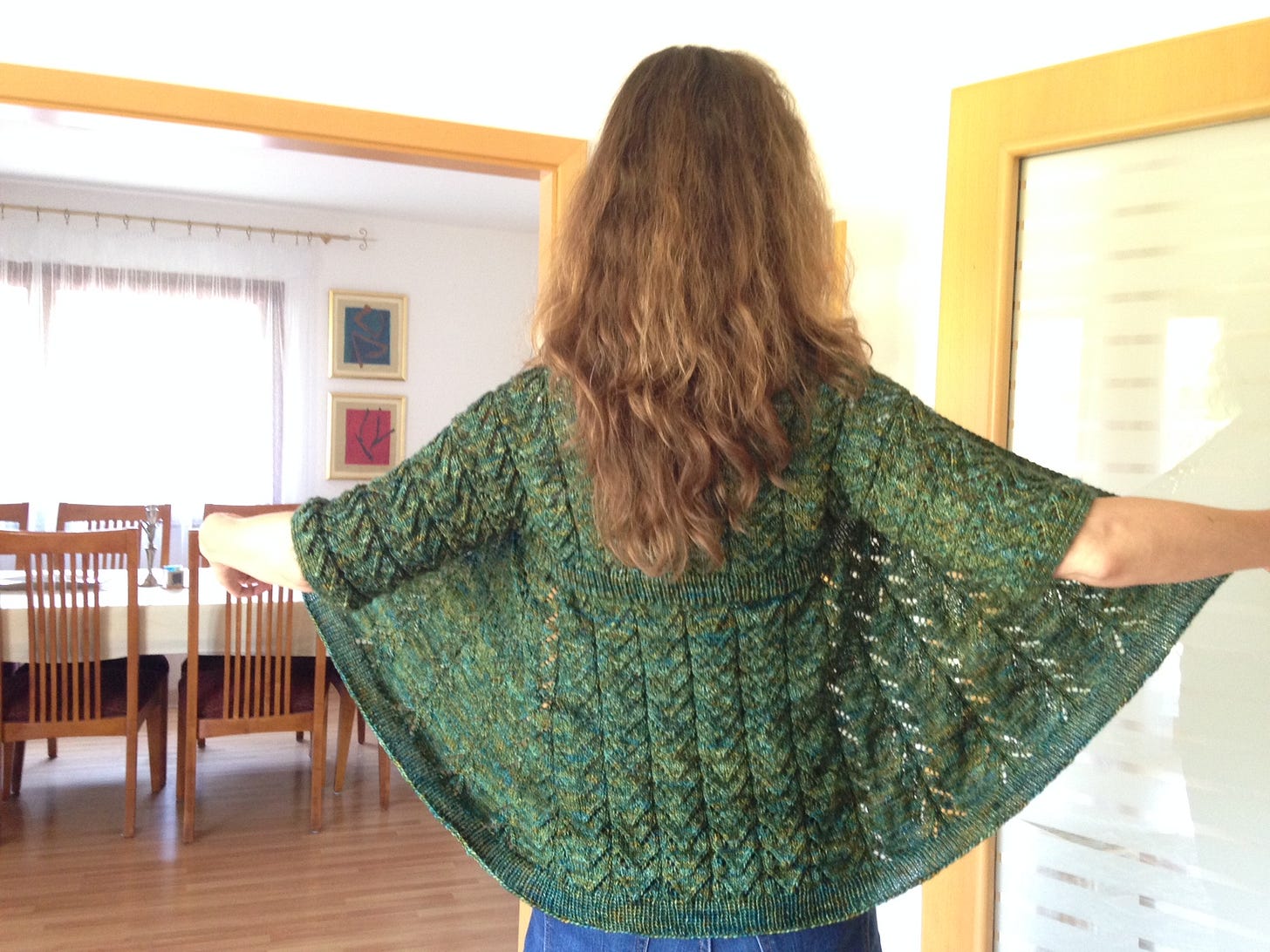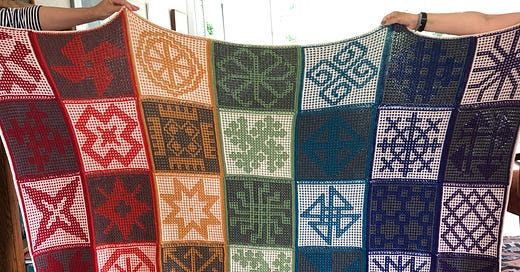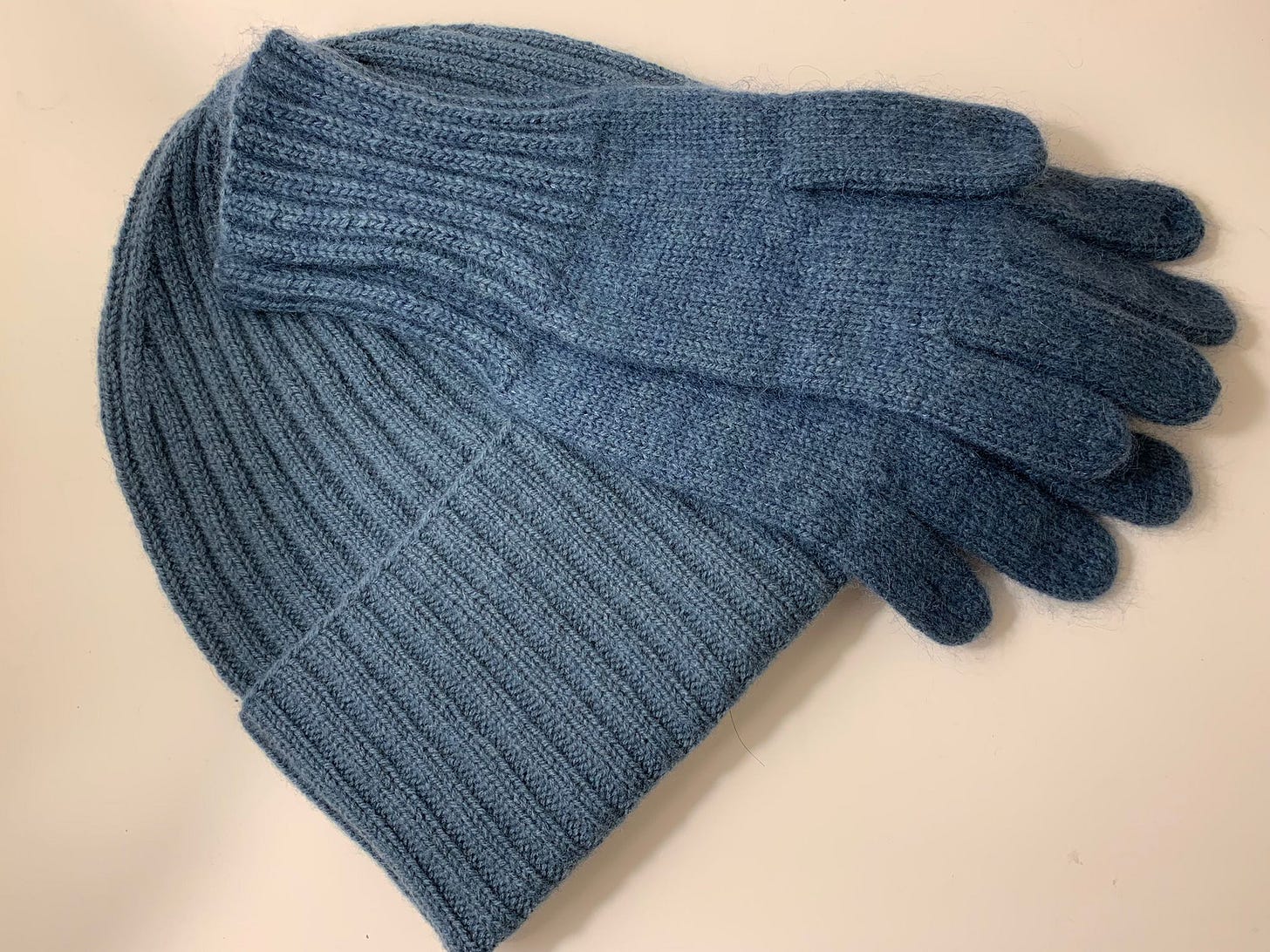Life Lessons from Knitting
"It was regular, it was repetitious, and in the end it amounted to something"
Note: The Happy Wanderer summer book club will begin next week, on July 21. The Turn of the Screw, by Henry James, is quite short (about 100 pages) but is famously ambiguous. Let’s solve the mystery together! What the heck is going on in this book? Do you think the ghosts are real, or are they a figment of the Governess’s imagination? What is your opinion of the children, Miles and Flora? What questions did the book raise for you? The book is in the public domain and is available here for free, or you can find it in your local library or bookstore. And if you’re not interested in reading the book, or you don’t have time, no worries! I will provide a brief plot summary at the beginning of next week’s post so that you can still enjoy the conversation. Happy reading! And now on to this week’s post.
I have been an avid knitter since the day, twenty-five years ago, when I gratefully accepted my friend Susan’s1 offer to teach me. She had recently been downsized from a high-powered job and was going nuts from boredom (the final straw was when she spent an hour organizing and color-coding her husband’s sock drawer). She knew that I, a teacher, was off for the summer and at loose ends too, so we figured it was the perfect opportunity. We met at her house every week; I brought the Clint Eastwood movies (we were both fans), Susan made the treats, and we knitted together. Since that summer I have knitted nearly every day and have absorbed lessons that apply to many other aspects of life. With the help of my master-knitter friends Anastasia, Bodil, and Inbar, I’d like to share these life lessons with you.2
People are pretty terrific, actually. If you want to feel uplifted, I recommend going on YouTube and searching for “knitting help.” You will discover thousands of videos from people who generously share their knowledge and skills, just to be helpful. We knitters also love to give our work away. (If you are interested in knitting for homeless people, here is a good resource page.) Once, when Anastasia was knitting at a cafe, an old man asked her if she would knit socks for him too. His wife, who had recently died, used to knit his socks, and he missed her. Now Anastasia knits a couple of pairs of socks a year for the man, plus pairs for his friend. Knitters keep small local businesses like yarn shops afloat, and we gladly pay extra to support artisans who design patterns or who hand-dye and hand-spin yarns.
It’s worth the trouble to learn something new. I like to learn new techniques with every project. At the beginning, I am always confused. “What is up with this pattern? Am I totally messing up?” I will ask myself. There will be a fair amount of rushing back to YouTube, or I may require a consultation with my knitting group, Crafts and Coffee. But there always comes a point when the new technique makes sense, and I get that lovely, satisfying “Aha!” feeling as the technique lodges itself in my hands. And, as a reward, the result often looks more impressive than warranted. For example, I spent about an hour learning mosaic knitting (this is the book I used), and here is the nifty blanket I made, which was much easier to knit than you’d think:
Don’t be too proud to accept help. Experienced knitters know that the best way to successfully execute a challenging pattern is to use row counters (I use two for complicated patterns), stitch markers, and other tools to help us keep track of what we’re doing. Below is the sweater I’m currently working on; I would definitely get mixed up and lose my place among the cables without my color-coded markers! It’s the same for any kind of learning: As a former volunteer for Recording for the Blind and Dyslexic, I am saddened by the controversy over whether listening to audiobooks counts as reading. Of course it counts, and if you need any other intervention to help you acquire knowledge or skills, by all means take advantage of it!
It’s ok to make mistakes and even to give up. Maybe some of you don’t need this lesson, but as a life-long perfectionist, I definitely do. In my regular life, mistakes represent failure, but knitting gives me ample opportunities to remind myself that if I make a mistake, it’s no biggie—I can just rip it out and fix it. (In fact, the knitting term for doing this is “frogging,” because you “rip it, rip it.”) Any knitter will agree that knitting is the antidote to perfectionism. As Inbar says,
Knitting involves a lot of planning in advance, being methodical, developing patience, as well as being humble. Every knitter, no matter how advanced, is bound to make mistakes sometimes. Facing the mistake either by unravelling the work and fixing it, or by accepting its presence, makes a great analogy for real-life situations.
Bodil is grateful that knitting has taught her “problem-solving, patience, and perseverance,” but she acknowledges that sometimes it’s ok to give up so as not to fall prey to the sunk-cost fallacy. When our project is going poorly and we’re no longer enjoying or benefitting from it, we will be happier and better off if we abandon it:
[It] is never too late to re-evaluate what you are doing. Don’t keep knitting on something you don’t believe is going to turn out well just because you feel you have invested so many hours on it already. It is better to take a break. . . . Spend that time on something worthwhile instead.
It’s relaxing to get out of our heads and think in a different way. Knitting is meditative. Especially for those of us who are highly rational and verbal, it makes for a nice change to switch to tactile, spatial, and creative thinking. We enjoy the feel of the yarn, the color combinations, the textures of the cables, and the click of our needles. I made the sweater below from a kit, which included the yarn and a small black-and-white chart, but no guidance on how to place the colors, because choosing where to put the colors is part of the fun.
And while a finished object is a nice bonus, it is by no means necessary. A friend’s teenaged son would combat stress by knitting a scarf, unraveling it, and knitting it back up again, like Penelope at the loom. He was more interested in the process than the product. For Anastasia, knitting is not just a hobby but is in fact a part of her personality: “The repetitive nature of knitting helps me to calm down, and then it’s more like meditation to me. Sometimes being focused on my knitting makes me feel more organized and guides me to solutions for different problems.” Bodil adds that
If I have had a stressful day and my brain feels like a fog, then it is perfect to have a knitting project with simple stockinette stitches so my hands can work by themselves, and I don’t have to think. Other times maybe I have too many different things on my mind at the same time and I need a more complicated pattern like a lace shawl or Fair Isle project to focus on to clear my head.
Below is an example of a Fair Isle project Bodil took on: “I decided to ‘swatch’ a whole cardigan in a more affordable yarn to make sure I understood the pattern and would be pleased with the outcome before starting on the final project.” As you can see from the photo of her second go-round with the pattern, the results are gorgeous!

Practice makes perfect, but you need talent too. Readers may be a bit uncomfortable with this lesson, especially because we like to think that any of us can do anything if we just set our minds to it, but I have found that many people lack the fine-motor control necessary for knitting.3 I know whereof I speak: For several years I taught knitting at my kids’ schools, and every year my student knitters fell into three groups: 1. One or two kids who already knew how to knit and needed only a couple of pointers from me, 2. One or two kids who took to knitting quite quickly (interestingly, these were often boys), and 3. Everyone else, who struggled with knitting, spent the lessons playing with the yarn, and quit as soon as the class was over. And that’s ok! We all have unique talents, and we will enjoy activities more—and be more willing to put in the practice—if we have some aptitude going in.
Only connect. Knitting binds us together: Although some people do learn to knit by watching the aforementioned YouTube videos, most of us were taught by a friend or family member. As Susan said when she taught me, knitting is an art that is transmitted from woman to woman. Bodil learned at her mom’s side when she was six: “My mother enjoyed working with textiles in different techniques, so there were always leftover pieces of fabric and yarn in the house where I grew up. That encouraged me to start knitting things for my dolls and Barbies.” Anastasia agrees that “knitting connects people. Recently it has become a part of my social life. I get tons of inspiration and experience from our Crafts and Coffee group. Watching my friends knitting fantastic sweaters has inspired me too.” Inbar connects her knitting with history in a powerful way:
A project I would like to invest in more is the re-creation of objects that were knit by Jews during the Holocaust in order to eternalize their stories. I replicated a pattern of mittens that were knitted during the Holocaust. I met the knitter and heard the story of her survival battle and how knitting saved her life. Here is a link for her pattern.
Women can do math. If you are wondering what connects knitting with math, well, have I got a story for you! A college friend was a math genius—in his junior year he placed first in the country on the Putnam exam, the “preeminent mathematics competition” for undergraduates in the US and Canada. One day I was reading in the library and noticed that he was wandering around, apparently aimlessly. I asked him what he was up to, and he replied, “I’m walking such that if I were to be trailing a string, it would be tied in a knot when I’m finished.”4 What is knitting, if not strategically tying knots, in order to transform a one-dimensional object—the yarn—into a three-dimensional object? That’s topology.
Pattern designers enjoy inventing new ways to turn a series of knots into shapes. Cat Bordhi, for example, created a way to knit a Möbius strip without cutting the yarn. I am not clever enough to design my own patterns, but I enjoy following them and I appreciate their construction. In the photo below I’m modeling a cardigan that is made continuously, without ever breaking the yarn—sleeves and all.

Anastasia knits socks and gloves without using a pattern, and she can resize them in her head as she goes, just through her intuitive sense of proportion—of how many stitches and rows she should be making for a given person’s hand or foot.
Inbar designs and sells shawls and their patterns in her online shop, Lefted Knits (you can find Lefted Knits on Ravelry, Facebook, Instagram, and Twitter). She, too, designs her pieces mostly in her head, and as you can see from the photo below, her lace patterns are extraordinarily intricate and beautiful. In her words, “Designing the shawls keeps my brain sharp as it involves math and imagination.”

How about you, readers? Any fellow knitters out there? Or what other hobbies do you enjoy, and what life lessons have you learned from them? Please share your thoughts in the comments!
The Tidbit
Please enjoy this relaxing knitting video. Be sure to watch with the sound on to hear the satisfying whisper of the needles.
The subtitle of this essay is a quote from At Home in Mitford, by Jan Karon.
In-born differences in fine-motor control are real. Remember Herr Professor Doktor Doktor from my “How to Spot an American” post? He had always wanted to be a surgeon, but his fine-motor skills weren’t good enough, so he became an anesthesiologist instead.
This activity was absolutely typical of the kind of thing students at my college did for fun.








your mathematics section reminded me of the quote, "knitting is tying a knot so complicated you can wear it when you're done".
Are you familiar with “Mari” sweaters?
http://www.marisweaters.com/
These most gorgeous completed sweaters used to be carried by a handful of retail shops here in Oregon but not now that I know of. Years ago I got one of their patterns and knitted a cardigan myself! I love the classic styles!